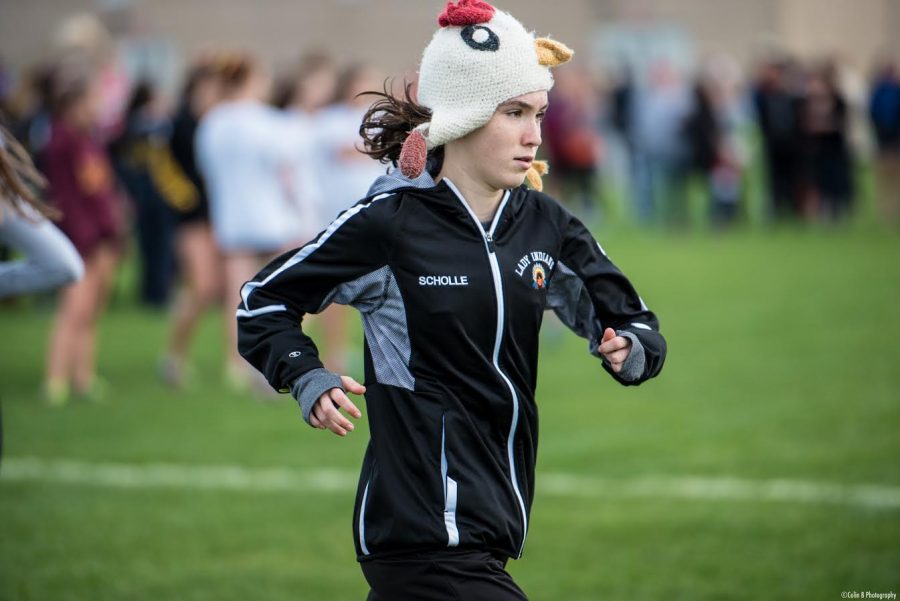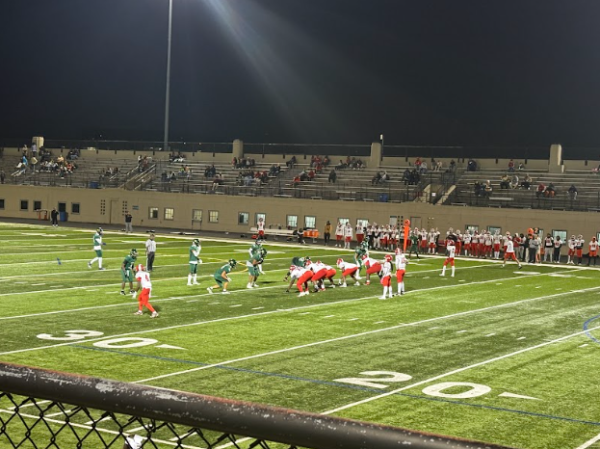Why did the chicken cross the finish line?
Scholle warms up in her lucky chicken hat before a regional race at Niles West High School.
Athletes are known to condition and train to prepare for the season to come. It helps assure a positive result in their upcoming games, since “practice makes perfect.” To add to their conditioning and practicing, some athletes also like to add a stretch or warm-up to build the assurance higher before a game.
And others like to wear a chicken hat.
“I always have compression socks and a chicken hat that I wear right up until the race,” said Maggie Scholle, Div. 776.
And if it’s not a chicken hat you are seeing a Lane athlete wear before an important game or meet, then it must be a specific playlist you’ll catch them listening to.
“I listen to the same playlist in the same order, starting at Nicki Minaj’s ‘Fly’ and listening to it from there,” said Maggie Grossman, Div. 859.
But Minaj’s “Fly” isn’t the only thing helping Grossman ensure a good game.
“I have a few pregame routines that I absolutely need to do,” Grossman said. “I stretch each sock three times before putting them on, tape my wrist and fingers the same exact way and I jump up and touch the crossbar before the game starts.”
In some cases, it is not just an individual performing these actions by themselves. During Boys Basketball team games, you can catch bench players holding up their hands high in the air when their teammates take free throws.
“It’s part of our culture,” Michael Rojas, Div. 775, said. “We feel the presence and support of our other teammates. We do it every time. It would be weird without it.”
The chicken hat, the taped fingers, and hands up aren’t just any type of actions; they are superstitions or rituals many athletes feel compelled to perform either before, during, or after games.
Maya Lilly, Div. 763, has been wearing her black Nike headband since her sophomore year in 2014. She says it feels “uncomfortable” to play without it.
“I think it’s a mental thing, and I still have bad games with the headband, but I truly believe that I would play much worse games without it,” Lilly said.
Not only do they feel uncomfortable without their superstition, they feel that it is an obligation to follow through with it before every game so they can play at their full potential.
“When it comes to volleyball, every season I have the same hair tie,” Emily Stummer, Div. 760, said. “If I lose it, it’s bad luck for me. It’s weird but it works.”
Without giving a reason as to how it works, she feels if these routines are not carried out, it will reflect into the game.
“During the season, I would always wear the same pair of socks,” Stummer said. “If I play good, and the next game I play bad, I go back to the routine I did on my good day so I can play good again.”
Sometimes the fear of injury also drives athletes toward superstition.
“I would run my fingers through the grass or turf we play on and then pray after I grab the grass or turf,” soccer player Alejandro Garcia, Div. 760, said. “It’s just a way to stay safe during the game. I feel that if I don’t do it, I would be less protected and more prone to injuries.”
What athletes sometimes don’t know is that it’s not the lucky chicken hat that’s making them believe in their superstitions, it’s what’s underneath it: Their brain.
Jane L. Risen, Associate Professor of Behavioral Science at the University of Chicago, said that there are “cognitive and motivational factors that give rise to superstitions.”
Risen explained in an email that from the cognitive perspective, the brain makes “fast judgements” that are involuntary, that do not need “to expend any cognitive effort, awareness, and intent.”
The cognitive side of the brain not only engulfs itself around its “fast judgments,” it also has to do with the athlete proving or disproving their superstition.
“People test ideas by trying to confirm them rather than trying to disconfirm them,” Risen said. “Once you have a hypothesis in mind (for example, grabbing the grass will keep me from getting injured), people repeat the action to test it rather than try to disconfirm the hypothesis by not doing it (for example, not grabbing the grass to find out I wouldn’t have gotten injured that way either).”
Uncertainty also plays a big role on choosing whether to rely on a superstition. People tend to lean towards their superstitions in order to be more secure about the amount of control they have on certain outcome. This is where the “motivational side” of the superstition comes into play.
“When facing uncertainty and feeling anxious it can feel better to have the sense of control, even if that control is illusory,“ Risen said.
Illusory or not, no one can invalidate the chicken hat’s three city championships and city record in the 3-mile.
Your donations directly fund the Lane Tech student journalism program—covering essential costs like website hosting and technology not supported by our school or district. Your generosity empowers our student reporters to investigate, write, and publish impactful stories that matter to our school community.
This website is more than a publishing platform—it's an archive, a research tool, and a source of truth. Every dollar helps us preserve and grow this resource so future students can learn from and build on the work being done today.
Thank you for supporting the next generation of journalists at Lane Tech College Prep!

I started off my Junior year as a J1 (Journalism 1) student and focused most of my work towards the sports here at Lane Tech College Prep. I have written...











